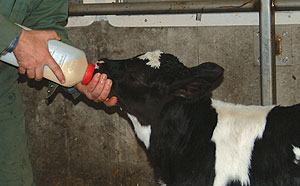Healthy Calf Conference
Follow to stay up-to-date on all Healthy Calf Conference updates. Speaker announcements, sponsorship information, registration announcements, and more.

If colostrum is good quality, free of blood, serum, mastitis, feed 4 litres to the calf within 30 minutes of birth. If colostrum is poor quality, use good quality colostrum that has been frozen or a good quality colostrum replacement product.
Feed another 2 litres of colostrum within 8 hours of birth. Feed calves 3 litres of colostrum two times per day at 12-hour intervals for 3 days and then switch to normal milk or milk replacer.
Do NOT feed milk from treated cows as it could leave residues.
New research challenges the status quo for colostrum management
Feed 200 grams of IgG (immunoglobulin G) or four quarts of colostrum (approximately 4 litres), whichever is more. Don’t feed less colostrum because it has a lot of IgG – the calf also needs the calories in the colostrum. Feeding just a set amount of colostrum that doesn’t have enough IgG will hurt calves in the long run by increasing the risk of failure of passive transfer. It is important to know the quality of colostrum to ensure calves get at least 200 grams of IgG.
Bottles, buckets, and nipples
Bottles, buckets, nipples, and other feeding equipment should be cleaned and sanitized after every use.
Follow to stay up-to-date on all Healthy Calf Conference updates. Speaker announcements, sponsorship information, registration announcements, and more.
The Codes of Practice are nationally developed guidelines for the care and handling of farm animals. They serve as our national understanding of animal care requirements and recommended practices.